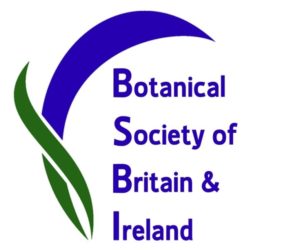Kirkcudbrightshire Botany Group, Kenmure Holms and castle, 18/05/2019
The theme for the day was to try to relocate three species, the nationally scarce Elongated Sedge Carex elongata, and the locally scarce Purple Iris Iris versicolor and Wood Small-reed Calamagrostis canescens, the last at its only VC site. However just three of us ventured forth from the New Galloway car-park along the flood bank of the site which is an SSSI and RSPB Reserve.
We started off with a selection of garden escapes alongside the burn feeding into the reserve from New Galloway. The pink-flowered Greater Bittercress Cardamine raphanifolia, the light green large leaves of Leopard’s Bane Doronicum pardalianches, Dogwood Cornus sanguinea, Rhododendron, both the standard Rhododendron ponticum and garden hybrids, Lungwort Pulmonaria officinalis, Berberis Barbarea sp. and Aquilegia Aquilegia vulgaris. Once we got clear of this area, we soon found a variety of sedges, which at the end of the day totalled 10: the bright green foliage and flower spikes of Water Sedge Carex aquaticus standing out as dense light green stands; smaller areas of Bottle Sedge C. rostrata with its dark blue-green leaves, around the pool edges or in winter flooding low-lying dips, and the long-liguled Bladder Sedge C. vesicaria. Inevitably there were stands of the fine-leaved and black heads of flowers of Common Sedge C. nigra; the glaucous, on both surfaces, leaves of Carnation Sedge C. panicea; the stiff-stalked spike and the differently coloured leaf surfaces of Glaucous Sedge C. flacca; and in a few areas the light green, small tufts of White Sedge C. curta. Some of the grass on the flood banks held two small sedges, Spring Sedge C. caryophyllea and Pill Sedge C. pilulifera. However the highlight of the day was to come much later on, just before we finished. There were a variety of trees/shrubs from Ash Fraxinus excelsior to Bird Cherry Prunus padus in full flower and Wild Cherry P. avium – why this way round as avium means bird?
In amongst all this we had Yellow Water Lily Nuphar lutea in one large pool/drainage channel; and Marsh Cinquefoil Comarum palustre in the marshy areas; Intermediate Lady’s -mantle Alchemilla xanthochlora in short grass, recognisable by its sparsely hairy mid-ribs on the under-surface of the leaves; Wood Horsetail Equisetum sylvaticum both fertile and sterile spikes, the fertile spikes predominantly on the east side of the flood bank and the sterile ones on the west side – why?
By this time we were into the second monad of the day where much of the above were seen again. Here the best additions were Gypsywort Lycopus europaeus recognisable by its large teeth of the light green leaves; Broad-leaved Pondweed Potamogeton natans; Figwort Scrophularia nodosa; Ragged Robin Silene flos-cuculi; and the shrub Guelder Rose Viburnum opulus. The walk back to the cars got more unexpected plants – Cyprus Spurge Euphorbia cyparissias, the hybrid crocosmia Crocosmia x crocosmiflora; and in disturbed ground next to the car park Early Forget-me-not Myosotis ramossima (new to the area), Wood Forget-me-not M. sylvatica and Field Forget-me-not M. arvensis. All distinguished by size and colour of flowers and the types of hairs present and where on the plant.
We then drove to the castle and walked down an avenue between magnificent mature and very tall Lime trees Tilia x europaea to the base of the castle mound which was covered largely with the yellow-flowered Tuberous Comfrey Symphytum tuberosum. There were however significant stands of the ancient woodland indicators Dog’s Mercury Mercurialis perennis, smaller areas of Wood Speedwell Veronica montana with hairs all around the stems, and Common Enchanters Nightshade Circaea lutetiana.
A short scramble down the slope to the marshy areas and we very quickly found our target species – mid-green clumps of the nationally scarce Elongated Sedge C. elongata, about 15 clumps in all of which 3 were growing on rotting fallen willow limbs. There must be more clumps in this bit of woodland, as it’s not where I saw them 4 years ago, which was almost beside a wire fence to the north of this patch. Only 30 sites up to 1999 in the UK, of which 3 are in VC73!
The walk around the castle produced what might well be specimen trees, of Yew Taxus baccata, Western Red Cedar Thuja plicata with its pineapple-smelling leaves when crushed; and others I didn’t recognise. There was also a stand of the 2m tall bamboo Sasa palmatum, presumably left from the original garden grounds. And that was it apart from checking the hawkweed on the nearby drystone dyke – Hieracium grandidens with large sharply-toothed stem leaves. One of the very few instantly recognisable species of this group to any other than hawkweed experts!
Final tally:136 species in one monad and 69 in the second one, making a total of 163 species. That apart, there was bird life – especially Grasshopper Warbler sounding like a high-pitched sowing machine, Sedge Warbler chattering harshly – and insects, including Orange-tip butterflies.
David Hawker
BSBI county recorder for Kirkcudbrightshire VC73

